Overclockable Pentium Anniversary Edition Review: The Intel Pentium G3258
by Ian Cutress on July 14, 2014 10:00 AM EST- Posted in
- CPUs
- Intel
- Pentium
- Overclocking
- Pentium-AE
- G3258
CPU Benchmarks
The dynamics of CPU Turbo modes, both Intel and AMD, can cause concern during environments with a variable threaded workload. There is also an added issue of the motherboard remaining consistent, depending on how the motherboard manufacturer wants to add in their own boosting technologies over the ones that Intel would prefer they used. In order to remain consistent, we implement an OS-level unique high performance mode on all the CPUs we test which should override any motherboard manufacturer performance mode.
HandBrake, SD Film: link
For HandBrake, we take two videos (a 2h20 640x266 DVD rip and a 10min double UHD 3840x4320 animation short) and convert them to x264 format in an MP4 container. Results are given in terms of the frames per second processed, and HandBrake uses as many threads as possible.
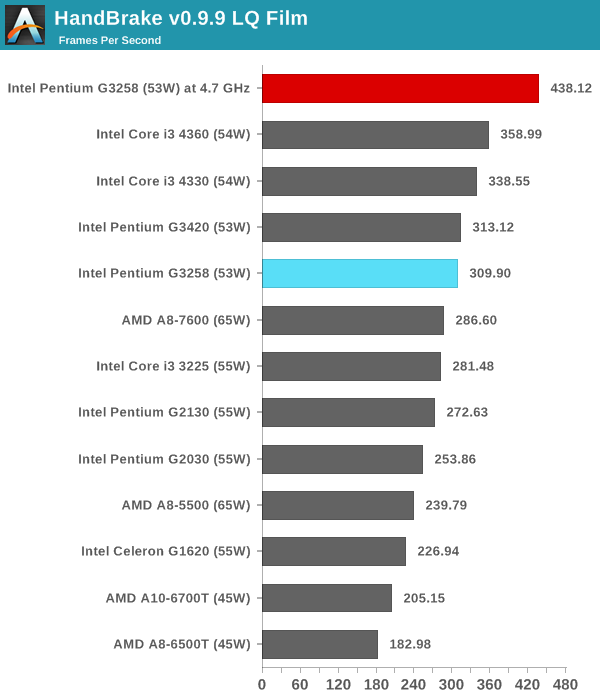
For low quality encoding, single threaded performance wins out over threads despite the extra multi-threading of i3 processors.
HandBrake, 4K60 Animation: link
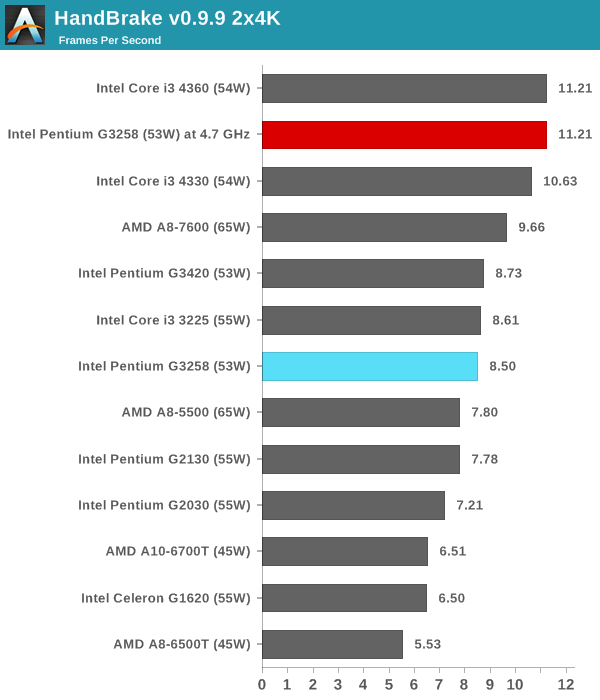
For larger frame sizes, the extra MHz of the overclock brings it on par with the i3-4360, although one might suggest spending the extra $40 for the i3 to ensure full stability.
Agisoft Photoscan – 2D to 3D Image Manipulation: link
Agisoft Photoscan creates 3D models from 2D images, a process which is very computationally expensive. The algorithm is split into four distinct phases, and different phases of the model reconstruction require either fast memory, fast IPC, more cores, or even OpenCL compute devices to hand. Agisoft supplied us with a special version of the software to script the process, where we take 50 images of a stately home and convert it into a medium quality model. This benchmark typically takes around 15-20 minutes on a high end PC on the CPU alone, with GPUs reducing the time.
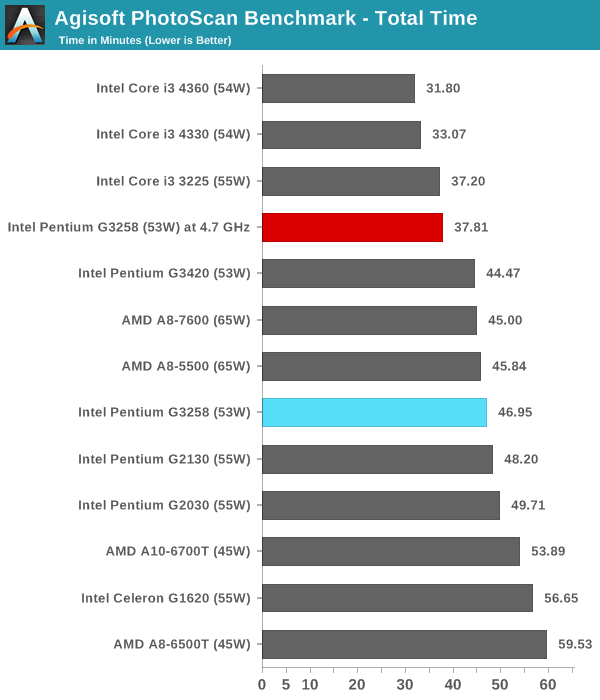
Dolphin Benchmark: link
Many emulators are often bound by single thread CPU performance, and general reports tended to suggest that Haswell provided a significant boost to emulator performance. This benchmark runs a Wii program that raytraces a complex 3D scene inside the Dolphin Wii emulator. Performance on this benchmark is a good proxy of the speed of Dolphin CPU emulation, which is an intensive single core task using most aspects of a CPU. Results are given in minutes, where the Wii itself scores 17.53 minutes.
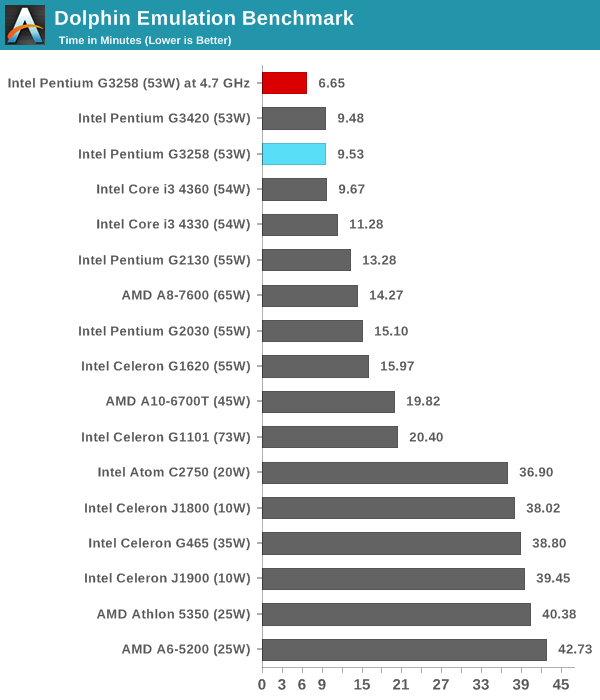
Dolphin is another example where Haswell combined with strong single threaded performance wins.
WinRAR 5.0.1: link
This test compresses a set of 2867 files across 320 folders totaling 1.52 GB in size – 95% of these files are small typical website files, and the rest (90% of the size) are small 30 second 720p videos.
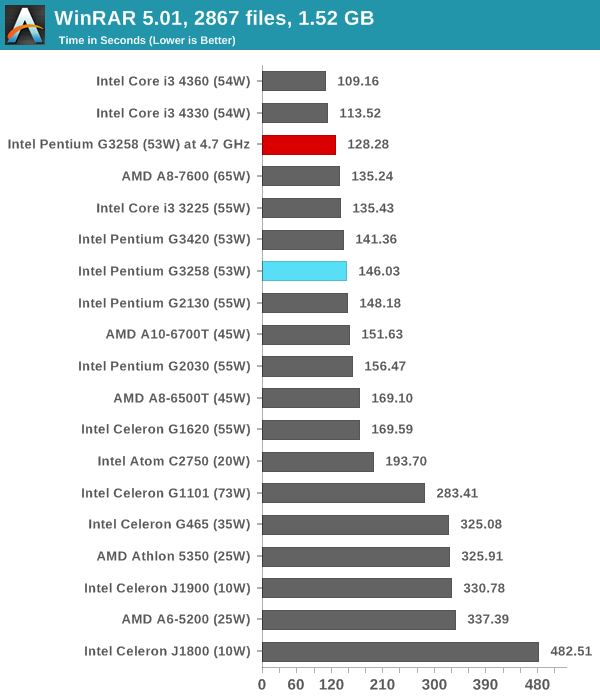
PCMark8 v2 OpenCL on IGP
A new addition to our CPU testing suite is PCMark8 v2, where we test the Work 2.0 and Creative 3.0 suites in OpenCL mode. As this test is new, we have not run it on many AMD systems yet and will do so as soon as we can.
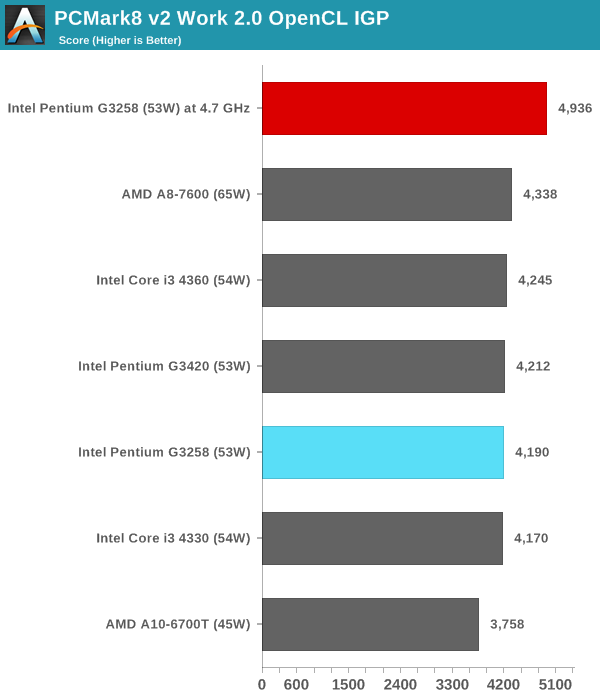
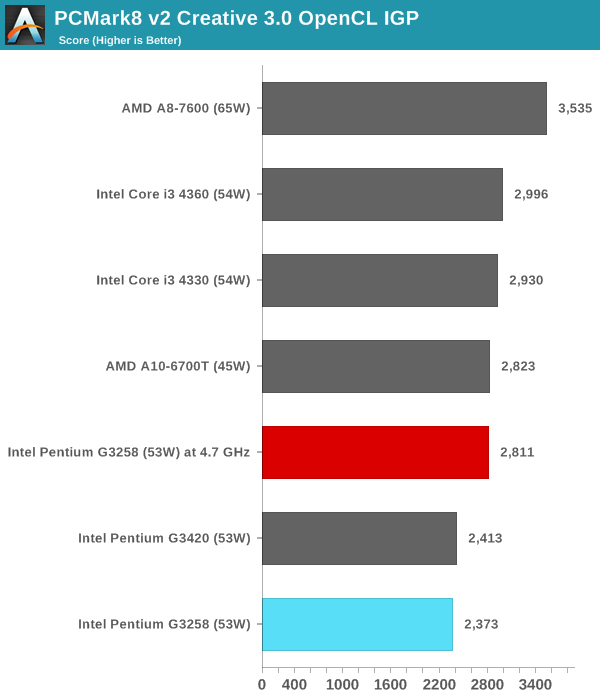
In both of our PCMark8 v2 results, overclocking the CPU gave a significant jump in performance. This would be down to the single threaded nature of parts of the benchmark, allowing web browsing and the snappyness of the system to be sped up.
Hybrid x265
Hybrid is a new benchmark, where we take a 4K 1500 frame video and convert it into an x265 format without audio. Results are given in frames per second.
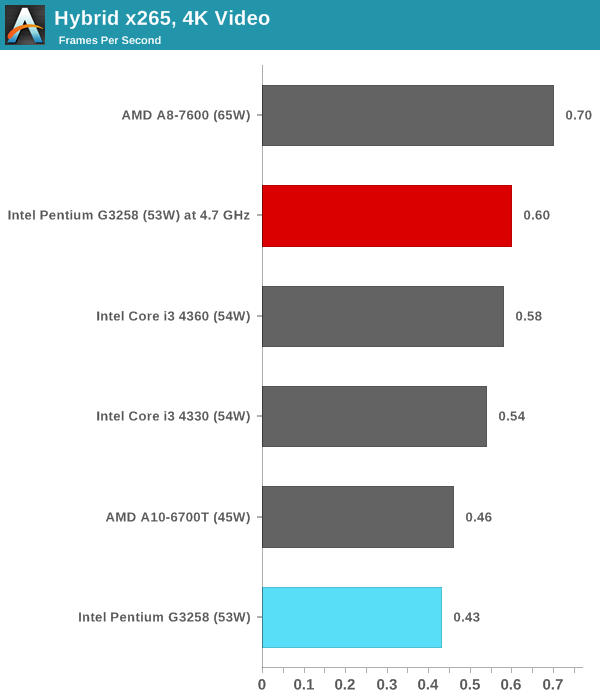
Almost an extra 50% performance for Hybrid x265 encoding.
Cinebench R15
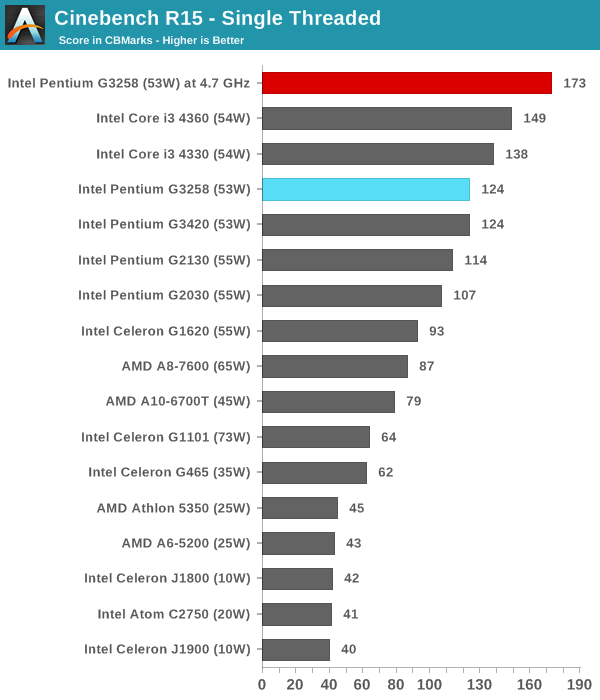
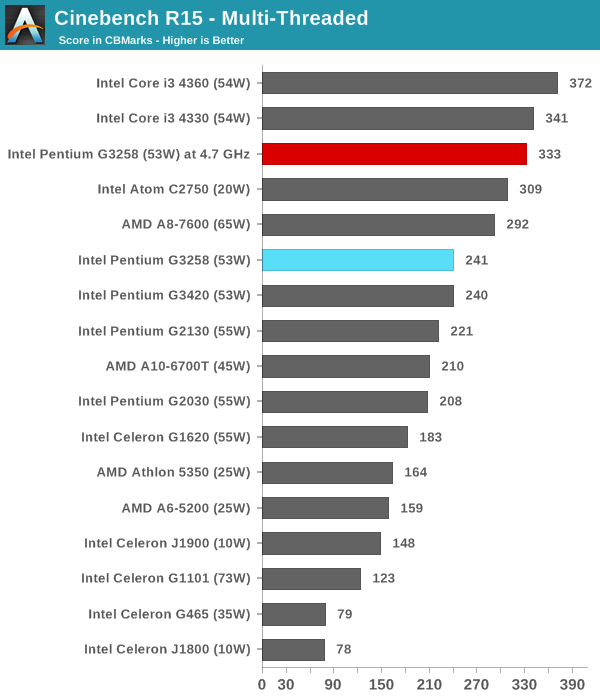
3D Particle Movement
3DPM is a self-penned benchmark, taking basic 3D movement algorithms used in Brownian Motion simulations and testing them for speed. High floating point performance, MHz and IPC wins in the single thread version, whereas the multithread version has to handle the threads and loves more cores.

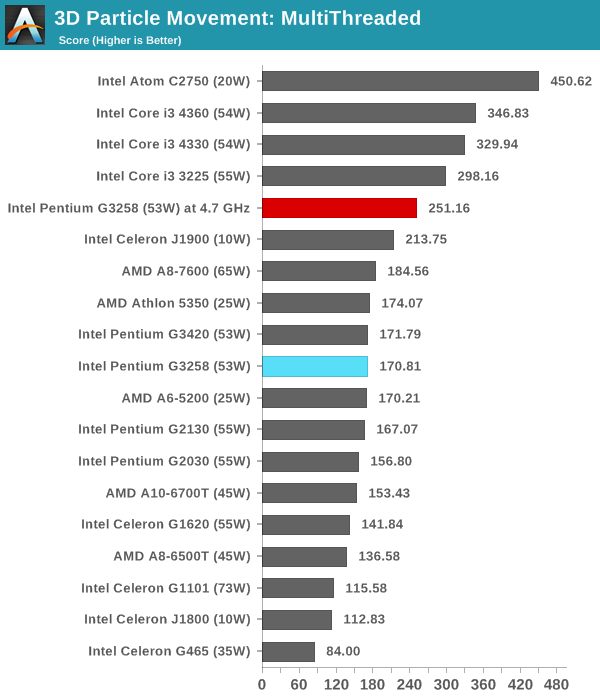
FastStone Image Viewer 4.9
FastStone is the program I use to perform quick or bulk actions on images, such as resizing, adjusting for color and cropping. In our test we take a series of 170 images in various sizes and formats and convert them all into 640x480 .gif files, maintaining the aspect ratio. FastStone does not use multithreading for this test, and results are given in seconds.
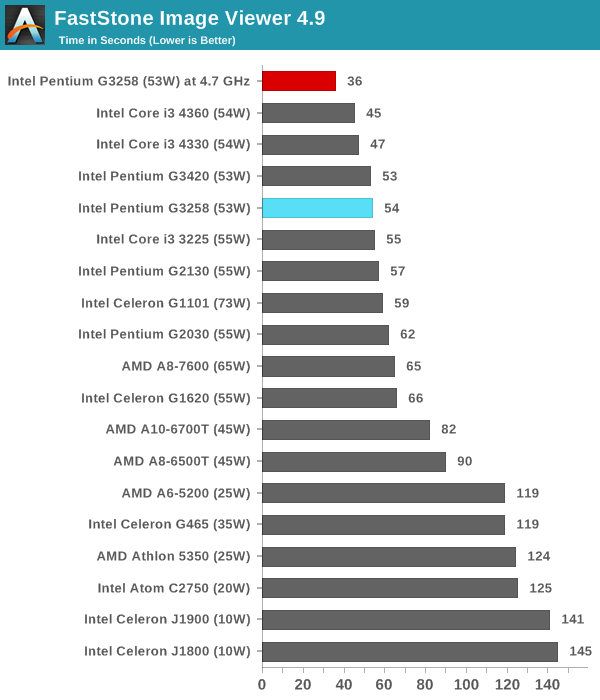
Web Benchmarks
On the lower end processors, general usability is a big factor of experience, especially as we move into the HTML5 era of web browsing. For our web benchmarks, we take four well known tests with Chrome 35 as a consistent browser.
Sunspider 1.0.2
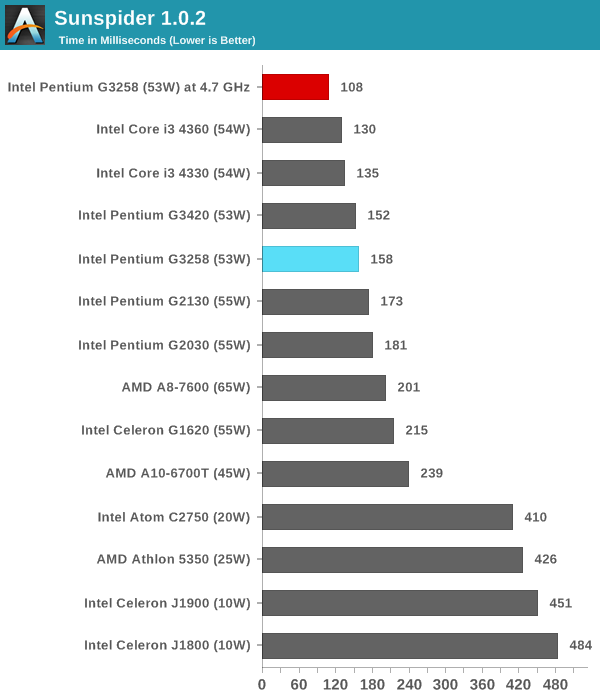
Mozilla Kraken 1.1
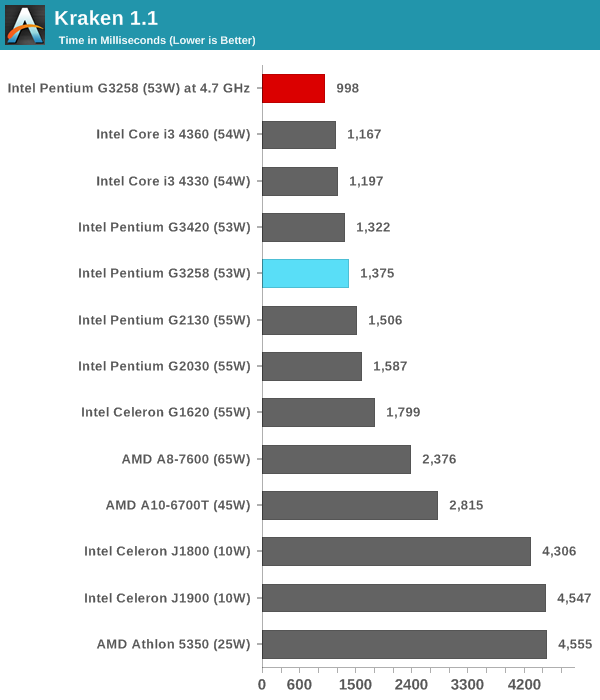
WebXPRT
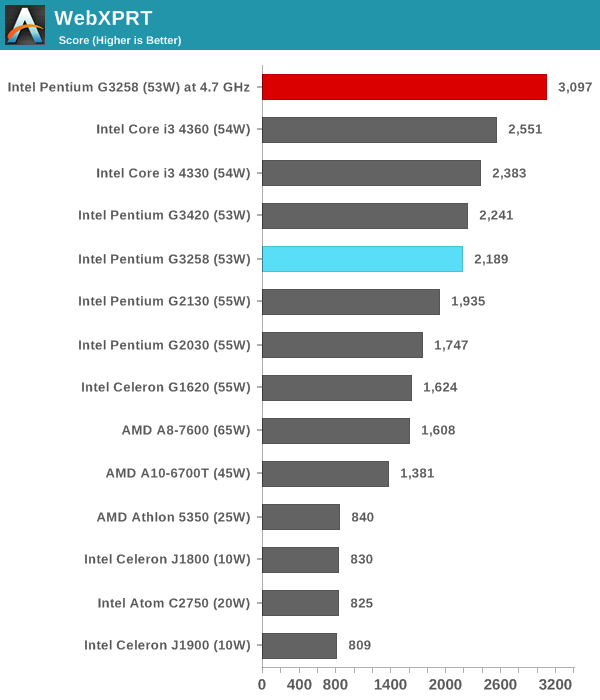
Google Octane v2
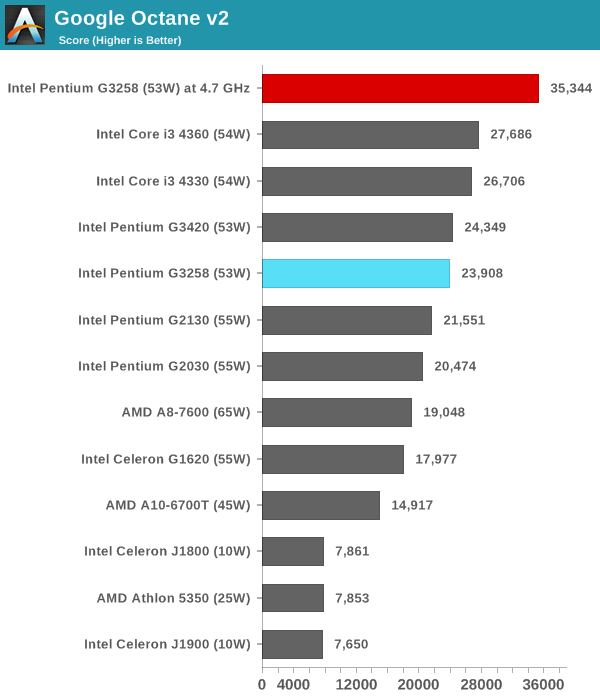
The usage model for an overclocked G3258 comes in highly single threaded environments. 4.7 GHz is nothing to be sniffed at, especially when it comes to web browsing or simple photo editing where it beats out more expensive processors. With multithreaded scenarios, it battles with the i3 depending on if the software can use hyperthreading to its full advantage. If the software can do that, then the i3 still wins out.










96 Comments
View All Comments
Ian Cutress - Monday, July 14, 2014 - link
Here is the FX-6350: http://www.anandtech.com/bench/product/1281Computer Bottleneck - Monday, July 14, 2014 - link
Non-Z motherboards capable of 4.5 Ghz with stock cooler start at $60 (and probably go cheaper than that.)So a Z board for overclocking Pentium G3258 is not necessary.
shortstuff - Monday, July 14, 2014 - link
What were the other components used during the test? I thought the test system components would be listed in the article.hojnikb - Monday, July 14, 2014 - link
Is pentium line using the same die as i3 ?Also, is intel planning on making more of these unlocked pentiums in the future (broadwell) or was this a one time dela ?
extide - Tuesday, July 15, 2014 - link
Yes, they are the same exact dies, pretty much. If Intel did it anything like they did with ivy Bridge, then basically there are 4-6* dies for the consumer Haswell chips. These dies are used in all lines from Celeron, to Pentium and i3/5/7, desktop AND mobile chips.2c/3MB/GT1
2c/4MB/GT2
4c/6MB/GT1
4c/8MB/GT2
*The R-series CPU's use 1 or 2 additional different dies. I know there is a 4c version, which has 6 or 8MB of L3, and GT3, and there may also be a 2c version as well, but I am not sure.
extide - Tuesday, July 15, 2014 - link
EDIT: For chips like the Celerons with 2MB of L3, they disable some of the L3 cache. Sometimes a SKU will use a 'higher'/bigger die than you would expect, with some parts disabled. It just depends on what Intel feels like doing/has more of at the time/etc.KAlmquist - Monday, July 14, 2014 - link
For an allegedly "unlocked version," the G3258 certainly has a lot of stuff locked.- Half of the GPU execution units (10 out of 20) are locked.
- One MB of cache is locked.
- The AVX instructions are locked.
- The AES instructions are locked.
- The transaction instructions (TSX-NI) are locked.
- I/O virtualization (VT-d) is locked.
- Hyperthreading is locked.
I'm sure that there is more stuff that I've missed. I'd guess that Intel has made somewhere around one third of the circuitry on the chip unusable.
MikeMurphy - Monday, July 14, 2014 - link
Nobody would be buying the more expensive i5 and i7 k-series CPUs if these weren't sufficiently impaired.It's a good CPU for someone who was going to buy a Pentium anyways. It shouldn't be changing much in terms of purchasing decisions otherwise.
OrphanageExplosion - Monday, July 14, 2014 - link
My guess is that we won't see an overclocked i3 because with 4.5GHz, hyper threading and a bit more cache, suddenly there's little need to buy a non-K i5 any more in a majority of use-case scenarios.SolarAxix - Monday, July 14, 2014 - link
Very good article.I actually bough a Pentium G3258 along with an MSI Z97 PC Mate for $99 plus tax at Microcenter.
I didn't expect anything magical from this purchase. It was easy to justify since I was getting the processor and the motherboard for less than the sale price of the motherboard which sells for $109.99.
I can see this being a great machine to surf the web and to do some Steam In-Home Streaming. Even OC to 4.5/4.6, it doesn't use much in electricity when it idles plus I got to upgrade my current low-end system with this new system. It has USB 3 and SATA 3 ports and a newer audio codec. Overall for me, it was a no-brainer. If it was more than $100, then I am not sure if I would made the jump or not.
If you are lucky enough to be close to a Microcenter, then this is a great deal for a low-end spare PC to play with.
( http://www.microcenter.com/site/brands/G3258Bundle... )